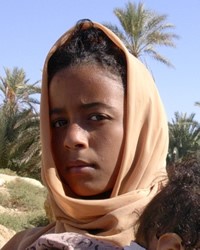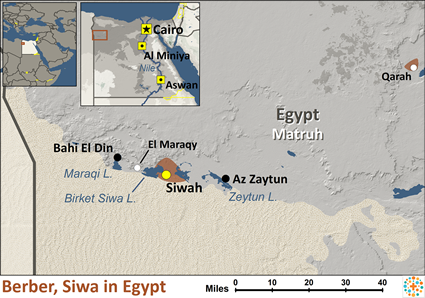The Siwa Oasis lies seventy feet below the surrounding desert. It is accessible by a gorge that is wedged between sandstone hills and worn into fantastic shapes by wind and weather. Inside the oasis there are refreshing pools with groves of olive trees and date palms. This is the homeland of the world's easternmost Berber tribe, the Siwas.
Long ago, Cambyses, the Persian king who conquered Egypt in 52 B.C., sent 40,000 men to attack the Siwa Oasis region. However, the soldiers neither reached their destination nor returned to Persia. Most likely they all perished in the desert.
Prior to the seventh century, Siwa Berbers had successfully resisted foreign invaders. However, with the Arab conquests of the seventh century, the Siwa Berbers were shattered. Some fled or were driven into the desert, while others submitted, becoming Arabized in language and, to some extent, racially mixed. All embraced Islam, the majority being Sunni Muslims.
Their settlements are protected by high walls. Building materials for walls and homes is usually bricks and hardened mud.
Siwa Berbers are primarily farmers whose staple crops include dates and olives. They also grow wheat, barley, sorghum, broad beans and onions. Men do the agricultural work. Most land is held as private property by individuals and can be bought and sold. Water rights are very important.
The Siwa do not keep camels, although they are used in the caravan trade. Domestic animals include cattle, goats, donkeys, dogs and sheep. Milk is an important element in their diet, as is the butter made from the milk.
Like other Berbers, the Siwa live in a patriarchal (male-dominated) society. They are Muslims, and according to Islamic law, inheritances are traced through the males. These religious principles also determine which portion of a man's estate goes to his widow; the balance is divided among his children, with full shares to sons and half shares to daughters. Wealth distinctions are very important to the Siwa. Servants make up the lower class of society.
Having only one wife is the prevailing Siwa custom, but they allow for polygamy (multiple wives). Marriage with first cousins is common. A tradition among the Siwa is that a bride, dressed in her finest clothes and with her hair plaited in forty braids, is led to the village pool on the eve of her wedding. There, an old woman bathes her and removes from her neck a silver disc of virginity. On the way home, the bride is intercepted by her fiancé's family. They present her with many gifts including forty dresses, of which seven must be worn-one on top of the other-on the wedding day.
Family life is patrilocal, which means that newlyweds live with the groom's parents. Sometimes a new level is added to the house to accommodate the young couple. Homes are typically rectangular and often several stories in height. They have walls of stone and clay, and flat roofs of thatch covered with earth. The town is run by a council of male chiefs. Although the chiefs are supposed to be elected, their sons often inherit their positions.
Although the Siwa Berbers observe Islamic fundamentals, many pre-Islamic traditional beliefs still persist. They are Sunni Muslims, yet there is a part of their culture that views Islam as an invading force. That ties them to their traditional beliefs.
The Siwa Berbers have never been successfully reached with the gospel. They live at an oasis, but they lack the water of life. Very few Christian materials are in their Siwi language.
Pray for Siwa Berber family leaders to have dreams of the righteous and victorious Christ and open the doors of their hearts to Jesus.
Ask the Lord to call his ambassadors to disciple Siwa Berbers who will disciple others.
Ask God to provide evangelistic tools and equipment needed to reach them both spiritually and geographically.
Ask the Lord to raise up churches that will plant more churches among Siwa Berbers.
Scripture Prayers for the Berber, Siwa in Egypt.
https://en.wikipedia.org/wiki/Siwi_people
https://journeythroughegypt.com/the-siwa-oasis-a-project-announcement/
https://egyptianstreets.com/2022/05/15/the-unseen-world-of-egypts-siwi-berber/
| Profile Source: Joshua Project |


























